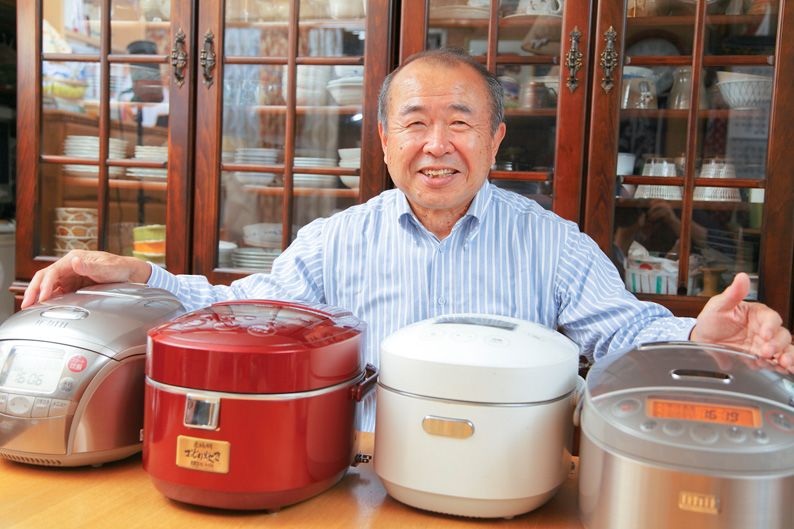
New Appliances for the Old Taste
Society Lifestyle- English
- 日本語
- 简体字
- 繁體字
- Français
- Español
- العربية
- Русский
From Cooker Specialist to Wizard of Pots
 Whereas Sanyō has a god of rice cookers, the Toshiba Group has a “wizard of pots.” He is Morimichi Nobuaki, Group Manager of the Microwave Oven and Cooking Appliances Products Planning Group Business Planning Department at Toshiba Home Appliances Corp. He has been involved with rice cookers for more than 30 years.
Whereas Sanyō has a god of rice cookers, the Toshiba Group has a “wizard of pots.” He is Morimichi Nobuaki, Group Manager of the Microwave Oven and Cooking Appliances Products Planning Group Business Planning Department at Toshiba Home Appliances Corp. He has been involved with rice cookers for more than 30 years.
“I’ve always had great respect for Sanyō’s Shimozawa, considering him to be my senior in research and development. He’s truly the ‘god’ in our field. My own work with electric rice cookers began as an engineer, after which I worked on product planning. Because it’s not usual at my company for an individual to specialize in just one area year after year, people began calling me the kama sennin [pot full-timer]. Then, punning on sennin [which with different characters means ‘ascetic’ or ‘wizard’], they nicknamed me the ‘pot wizard.’”
While Morimichi speaks with humility, he is in fact one of the best when it comes to the development of rice cookers. “We’ve set our sights,” he says, “on products that bring consumers the taste they see as ideal: delicious rice cooked in a pot on a kamado.”
Japan’s First Electric Rice Cooker
In 1955 Toshiba Corp. put Japan’s first electric rice cooker on the market. Until then housewives had to watch the kamado closely while the rice cooked, making adjustments in the degree of heat applied from time to time. The idea behind the electric rice cooker was to lighten the household duties of women by making this task unnecessary.
In the 1980s the battle over rice cookers intensified, with eight companies developing products to increase their share of the market. Microprocessors were introduced to add more automated controls, after which induction heating came into use to increase the cooking temperature. Toshiba, however, seemed content to rest on the laurels of its proven expertise in rice cooker technology. Because it was slow to apply the new technologies, its sales fell into a slump.
In a bid to rescue Toshiba from the brink of defeat, Morimichi channeled his efforts into the development of a better pot. The new model went on sale in 1994 under the brand name Kamadodaki. “We focused in particular on the inner pot,” he says, “because it’s a key part—one that determines how the rice comes out.”
He explains: “Electric rice cookers applied only weak heat before the advent of induction heating, and that made it hard for them to reproduce the taste of rice cooked over the flames of a kamado. The key to applying strong heat lies in the materials used to make the inner pot. We wanted to mix stainless steel, a pyrogenic substance, together with aluminum, which is an excellent heat conductor. At the time, though, our company lacked the technology to shape a pot from a metal sheet made of a combination of metals. Our engineering department was located in Niigata Prefecture near the cities of Kamo and Tsubame, traditional centers of the metal-processing industry, so we made the rounds of plants in other industries in search of technological hints. After much trial and error, we found we could apply a technique known as the ‘squeeze-casting process,’ which is used in the auto industry. That’s how we created the inner pot.”
He adds, though, that getting the Kamadodaki to the market still required much effort. From the start of development, it took three years before they had confirmed the feasibility of mass production and started manufacturing the final products.
 When participating in rice-related events, Morimichi often dons an apron bearing the characters for “wizard of pots.”
When participating in rice-related events, Morimichi often dons an apron bearing the characters for “wizard of pots.”
Morimichi’s Memory of the Most Delicious Rice
Morimichi agrees that rice cooked on a kamado is the tastiest. “As a child,” he recalls, “rinsing the rice before cooking was one of my daily household chores. My family and our relatives dined on kamado-cooked rice. I want the electric rice cookers we’re now developing to reproduce that taste. No matter how good we get at creating electric cookers, my memories of that rice still form my image of the ideal taste.”
(Originally written in Japanese. Interview of Shimozawa by Nogami Tomoko. Photos of Shimozawa by Miyamae Sachiko and of Morimichi by Matsuzaki Nobusato.)
Related Tags
Electric rice cooker Tottori Sanyō Electric Toshiba Home Appliances Induction heating Odoridaki Kamado Kamadodaki Microprocessors High-tech Shimozawa Masayuki Morimichi Nobuaki


